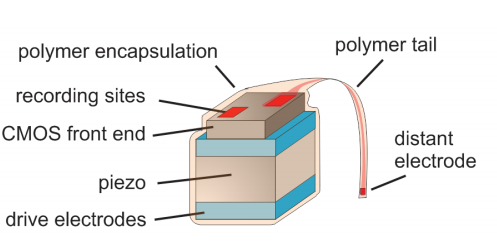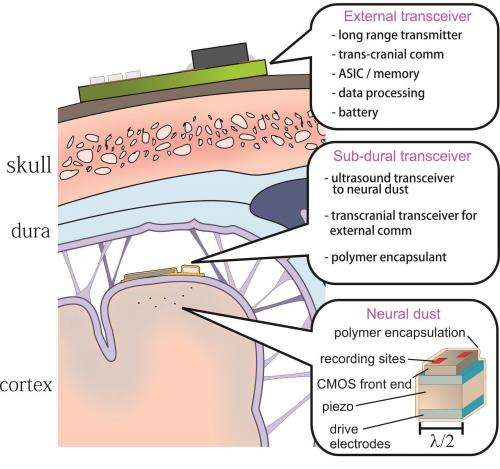July 17, 2013 report
Ultrasonically-interrogated neural dust for the ultimate brain interface

The fantastic mechanical isolation of the brain in the skull, makes high impact maneuvers, like heading a soccer ball, routine for an organ that would otherwise barely hold up under its own weight. The downside of this level of protection is that accessing the brain for large scale activity recording is a difficult proposition. The current state of the art in simultaneous electrical recording is around 2,000 neurons. This was done by Miguel Nicolelis as part of his ambitious project to build a brain computer interface (BCI) that will be used by a paralyzed person to perform the opening kickoff in an upcoming World Cup soccer match.
We recently reviewed a detailed exploration, by Adam Marblestone et. al., of the various technologies available for squeezing significantly more recording channels into the brain. One technology among these, ultrasound, is particularly enticing for bridging the "last mile," between hardware inside the skull, and the actual recording sites adjacent to neurons. A new paper in the Arxiv preprint server combines abstract conceptual ideas with detailed design and analysis to present a workable strategy for achieving this. Their method for cracking the cerebral nut involves peppering the cortex with CMOS-based "Smart Dust" sensors which can be interrogated through ultrasonic hubs strategically quartered a few millimeters above.
The problem with using electromagnetic radiation (in particular RF), to power and communicate with embedded recording elements, is that a significant amount of the transmission energy is deposited in the tissue along the way. The comparatively lower acoustic velocity in tissue accompanies a much-reduced wavelength for ultrasound compared to RF. At the scales relevant to intracortical recording, this smaller wavelength translates the transmission characteristics into the "far field." The hubs can therefore isotropically radiate, or insonate, dispersed dust motes with greater coverage, while still permitting some selectivity via frequency binning. At 10 MHz, for example, the wavelength of ultrasound in brain tissue would be around 150 microns while for RF it might be around 5mm. At 5mm wavelength, antenna systems for RF would operate at suboptimal efficiency.
The dust motes themselves are are envisioned as relatively simple CMOS circuits coupled to a piezoelectric elements for receiving and re-transmitting ultrasonic power. An active mote design would recover and rectify power, and also be able to perform some preprocessing of acquired neural signals. A more compact footprint might be made by using a passive mote design, which extends the concept of passive RFID to include modulating the backscatter with measured neural potentials. This devilish design might be no larger than 100 microns (comparable to a pyramidal cell), and use only a single FET along with a couple of resistors.
The feasibility of a passive mote hinges on it being able to intercept sufficient power from the ultrasonic hub, and also on the ability to sense sufficient voltage at the gate of its FET. In designing optimal ultrasonic systems for the brain there are many trade-offs, and some starting point most be chosen to move forward. The "Raleigh distance," is the point where transition to the far field occurs. Here the pressure field converges to a natural focus and a mote placed at this distance can maximize received power. Assuming 10MHz resonant frequency, this distance would be around 2mm, an ideal span for motes placed within the cortex to intercept radiation from overlying hubs. An optimal external dimension for these hubs would be on the order of 1 millimeter.

I asked corresponding author Dinjin Seo a few question regarding the subdural placement of the hubs on the cortical surface. He noted that ideally, the back face of the of the interrogator, that facing the fluid environment of the dura, would have a significant impedance mismatch to reduce undesirable energy coupling in that direction. The face opposing the motes on the cortical surface, if better matched, could transmit at well above 50% efficiency in that direction. The hubs are assumed to be powered from an external RF source with which they communicate in the same way. Bone significantly attenuates ultrasound (approximately 22 dB/(cmMHz)for the skull) and this method of communication would not as effective here as RF. Dust motes could in theory be dispersed at 100 micron separation, while the interrogator hubs might be separated at distances of 1 mm.
Proximity to the skull is one advantage of this cortex-specific ultrasonic implementation. This system might however be even more effective if adapted to an interior ventricle location. If spike maps are all that one is after, placement of motes within the white matter tracts adjacent to the ventricles has a certain appeal. Toxicity of the hardware, for example, might be in theory be arbitrarily reduced by polymer encapsulation, however the longer term effects of the physical presence of motes, and of the rarefraction-compression cycles they transduce may prove too much for some cells. Axons are protected by a heavy layer of myelin and working with these natural structures may provide for safer coupling strategies. Should an axon be compromised, grey matter neurons with collateral branches would likely survive the assault.
The paper explores conventional concepts regarding safety limits to ultrasonic and electromagnetic radiation. They developed models which include the so-called KLM descriptions of piezoelectric networks to provide essential characterization of performance. Phantom brain models will also be needed to provide actual measurements to supplement the models, and a more fine-grained appreciation for the heterogeneity of brain tissue would also be helpful. An average temperature rise of 1 degree C may in theory be an acceptable limit, however local tissue concentrations might be expected to occur in much the same way that an average 1 meter tide might be expected to be a 10 meter tide when concentrated by the Bay of Fundy.
One additional consideration might be properly buttressing hubs and motes against the natural material flux of the brain. Accumulation of this hardware over time at key drainage points in the brain, or foramen between ventricles may be at once undesirable from durability point of view, but desireable should the motes prove dangerous. As Marblestone has noted, the open sharing of detailed calculations and designs at multiple levels of abstraction, as done to near perfection here, is critical to the moving forward in this groundbreaking field as fast as possible.
More information: arxiv.org/pdf/1307.2196v1.pdf
© 2013 Phys.org

















